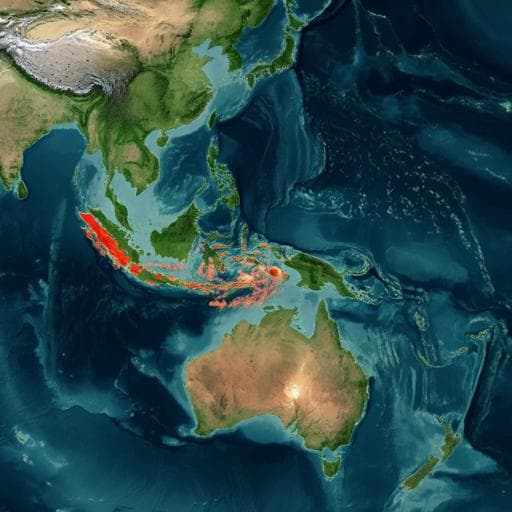
Earth Sciences
Role of the Maritime Continent in the remote influence of Atlantic Niño on the Pacific
S. Liu, P. Chang, et al.
Explore how the Atlantic Niño influences the Pacific and sparks a La Niña-like response by uncovering the role of atmospheric waves and the Maritime Continent's geography. This groundbreaking research by Siying Liu, Ping Chang, Xiuquan Wan, Stephen G. Yeager, and Ingo Richter reveals critical interactions vital for accurate climate simulations.
~3 min • Beginner • English
Introduction
Seasonal climate forecasts rely heavily on understanding El Niño–Southern Oscillation (ENSO) dynamics, yet forecast skill remains limited. Although ENSO develops in the tropical Pacific, variability in other basins, notably the equatorial Atlantic, can influence ENSO’s onset, evolution, and termination. Prior studies have suggested that Atlantic Niño (Atlantic Zonal Mode) can remotely force a La Niña-like response in the Pacific, with recent events (e.g., the strong Atlantic Niño in boreal summer 2021 preceding a winter 2021/22 La Niña) consistent with this premise. However, the significance of Atlantic forcing on ENSO has been questioned, leaving uncertainties about the mechanisms. A commonly invoked framework describes a fully developed anomalous Walker Circulation with ascent over a warm equatorial Atlantic and descent over the western/central Pacific, but it does not explain how this circulation is initiated and where it first develops. This study addresses key questions: how and where does the anomalous Walker Circulation outside the equatorial Atlantic develop in response to Atlantic Niño SST forcing, and what dynamical processes are responsible? Combining observational analyses with large-ensemble climate simulations, the authors investigate the mechanisms underlying the Atlantic-to-Pacific teleconnection and the role of the Maritime Continent in initiating and regulating the Pacific response.
Literature Review
Multiple studies (e.g., Zebiak 1993; Rodríguez-Fonseca et al. 2009; Keenlyside et al. 2013; Ham et al. 2013; Polo et al. 2014; McGregor et al. 2014; Kucharski et al. 2015; Li et al. 2015; Ruprich-Robert et al. 2017; Chikamoto et al. 2020; Richter et al. 2021) have explored Atlantic–Pacific interactions, suggesting that Atlantic Niño can modulate Pacific conditions and potentially enhance ENSO predictability. Some works, however, question the robustness or significance of this influence (e.g., Kucharski et al. 2011; Ding et al. 2011; Zhang et al. 2021). Mechanistically, a Matsuno–Gill response to equatorial Atlantic heating implies an eastward-propagating Kelvin wave and a westward Rossby wave as possible pathways for teleconnection, yet details of where and how the anomalous Walker Cell first develops remain unclear. Prior studies have not fully validated the Kelvin wave pathway within a coupled modeling framework, nor clarified the role of Maritime Continent orography and land processes in anchoring or modulating the teleconnection.
Methodology
Observational analysis: Partial lag-regressions were performed against the normalized May–June–July (MJJ) ATL3 index (SST anomalies averaged over 20°W–0°, 3°S–3°N) after linearly removing the preceding December–January–February (DJF) Niño3.4 index (170°W–120°W, 5°S–5°N) from all variables to reduce ENSO’s influence on Atlantic variability. Robustness was tested by alternatively excluding strong ENSO years (DJF Niño3.4 exceeding 1 standard deviation). Datasets include HadISST SST (1°×1°, 1959–2021) and winds (175–1000 hPa) from ERA5 (1959–2021), ERA-Interim (1979–2018), and JRA-55 (1959–2021). Wind fields from the three reanalyses were averaged over common periods to reduce internal variability. ERA5 precipitation, moisture flux divergence (Div(Uq)), vertically integrated moisture divergence (qDivU), and evaporation were used to diagnose moisture budgets. Statistical significance was assessed at the 10% level using two-sided Student’s t-tests for vectors and fields shown.
Large-ensemble pacemaker experiments: The Community Earth System Model (CESM1.1.2) was used at nominal 1° resolution with POP2 ocean (60 vertical levels), CAM5.2 atmosphere (30 hybrid levels), CLM4 land, and CICE4 sea ice. Three ensembles were conducted, each with + and – Atlantic Niño SST anomaly forcing imposed over the tropical Atlantic (24°S–24°N; restoring to model daily-mean climatology ± prescribed anomaly with a 5-day restoring timescale and 8° meridional buffer):
- CTRL: Realistic Maritime Continent (MC) land and topography.
- NTOP: Same Atlantic forcing; MC topography flattened over 93°E–152°E, 10°S–10°N to isolate orographic effects.
- NFRC: NTOP configuration plus reduced MC land friction by setting land momentum roughness length Zom to 1×10⁻10 m in CLM4 to examine frictional dissipation effects.
Each set comprised 60 ensemble members integrated for 1 year, initialized with slightly perturbed atmospheric states and identical ocean initial conditions representing a neutral ENSO state (Jan 1, 2006 of a long preindustrial control). Responses were computed as differences between ensemble means forced by + and – SST anomalies (e.g., CTRL+ minus CTRL–), assuming weak nonlinearity; supplementary analyses assessed nonlinearity. Geopotential height, winds, precipitation, SST, ocean heat content, and zonal mass stream-function (computed from equatorial divergent zonal winds integrated from 175 to 1000 hPa between 5°S–5°N) were analyzed to diagnose Walker Circulation and teleconnection pathways.
Experimental considerations: The Atlantic Niño forcing pattern was derived by regressing HadISST (1870–2017) JJA SST anomalies onto the ATL3 index; the same pattern multiplied by –1 forced the negative ensembles. The model retains mean-state biases (typically <±1 °C in the tropics), but differencing + and – experiments reduces bias impacts. Statistical significance was evaluated at the 10% level.
Key Findings
- Observations show the earliest remote atmospheric response to Atlantic Niño as easterly anomalies over the Western Pacific (WP) and Maritime Continent (MC) during boreal spring, concurrent with westerlies over the western equatorial Atlantic, consistent with a Matsuno–Gill-type response and an eastward-propagating atmospheric Kelvin wave.
- A local Walker Cell over the MC–WP region initiates in spring, with ascent to the west of the easterlies and subsidence to their east; precipitation anomalies primarily reflect circulation-induced moisture convergence/divergence rather than evaporation changes.
- As Atlantic Niño peaks in summer, easterlies and equatorial Pacific cooling intensify and extend eastward via Bjerknes feedback, leading to a basin-wide La Niña-like response that matures in boreal winter.
- Large-ensemble CESM experiments (CTRL) reproduce the observed teleconnection: geopotential height at 200 hPa shows a fast Kelvin wave reaching WP/MC within ~2 months after forcing onset and becoming quasi-stationary there while strengthening; a weaker Rossby component propagates westward but is ineffective at triggering equatorial Bjerknes feedback.
- Local Atlantic Bjerknes feedback (via subsurface/ocean heat content changes responding to trade wind anomalies) modestly modulates equatorial Atlantic SST and may enhance the remote Pacific response in summer.
- Maritime Continent orography: Removing MC topography (NTOP) weakens spring convection over MC, shifts the developing local Walker Cell and associated cold SST anomalies eastward; by boreal fall the Walker Cell is displaced ~20° to the east relative to CTRL, and equatorial Pacific cooling is likewise shifted eastward.
- Maritime Continent land friction: Further reducing MC land friction (NFRC) allows Kelvin wave energy to propagate farther into the central/eastern Pacific, strengthening easterly anomalies, enhancing Bjerknes feedback in the CP/EP, and producing a stronger and more eastward-extended La Niña-like response. The Walker Cell becomes stronger and more extensive.
- Overall, the MC acts both as a moisture-convergence trigger (via orography) to initiate a local Walker Cell and as a dissipative anchor (via land friction) that regulates where and how strongly the Pacific response develops.
Discussion
The study clarifies the initiation and evolution of the Atlantic-to-Pacific teleconnection. A warm equatorial Atlantic anomaly excites an atmospheric Kelvin wave that transports easterly anomalies eastward across the Indian Ocean to the WP/MC. Interaction with MC orography enhances moisture convergence and convection, helping to establish a local Walker Cell over the MC–WP. Land friction over the MC dissipates Kelvin wave energy, effectively anchoring the easterlies and local circulation. This circulation then couples with the ocean through Bjerknes feedback, inducing upwelling and surface cooling that intensify and spread eastward, culminating in a La Niña-like state. The findings indicate that model representation of MC terrain and land-surface processes critically influences the position and strength of the Pacific response to Atlantic forcing, with implications for ENSO simulation and seasonal prediction. Given that most current models have coarse resolution (~100 km) and may underrepresent MC topography and land–atmosphere interactions, there is a risk of underestimating or misplacing the teleconnection response. The results argue for improved resolution and physics in the MC region and motivate coordinated multi-model experiments to assess robustness and impacts on predictability.
Conclusion
This work confirms the atmospheric Kelvin wave as the primary pathway linking Atlantic Niño to Pacific ENSO and demonstrates that Maritime Continent land processes—specifically orography-driven moisture convergence and land-frictional dissipation—regulate the initiation, position, and strength of the Pacific response via a local Walker Cell and subsequent Bjerknes feedback. Improving the representation of atmosphere–land–ocean interactions and orography over the MC in climate models is essential for realistic simulations of Atlantic–Pacific teleconnections and potentially for enhancing ENSO prediction skill. Future research should: (1) assess sensitivity to model resolution and orographic detail, (2) perform coordinated multi-model intercomparison with common experimental designs, and (3) further explore nonlinearity and state dependence (e.g., varying initial ENSO conditions) in the teleconnection.
Limitations
- The study focuses on mechanism elucidation rather than quantifying the overall significance of Atlantic Niño impacts on ENSO predictability.
- Model limitations include relatively coarse horizontal resolution (~1°), which may underresolve MC orography and associated land–atmosphere processes.
- The Atlantic Niño forcing is idealized and time-invariant in the pacemaker experiments, which may not capture event-to-event variability.
- Analyses rely on differences between + and – forcing to mitigate biases and assume weak nonlinearity; although assessed, residual nonlinear effects may remain.
- Single-model framework (CESM1.1.2) limits generalizability; multi-model confirmation is needed.
- Initial conditions are neutral ENSO; teleconnection behavior may depend on background state and seasonality beyond what is covered here.
Related Publications
Explore these studies to deepen your understanding of the subject.







